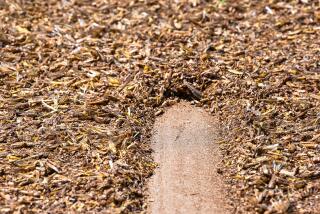More Than Drought Harms Rangeland, Officials Say
TONTO NATIONAL FOREST, Ariz. â With a sweep of his arm, Eddie Alford takes in the lifeless tableau: a gaunt landscape of withered shrubs, desiccated cactuses and bare mounds where grasses once sprouted.
Congress, the public and ranchers are quick to blame drought for these conditions, which have forced the withdrawal of cattle herds from nearly 70% of public grazing land in the Southwest, including this starved stretch of Tonto National Forest.
Alford, a biologist for the U.S. Forest Service, has a different view. He believes that decades-old polices by agencies such as his, as well as poor practices by ranchers themselves, have brought public rangelands to this sorry shape.
âWe have some [ranchers] who have stocked 10 times the cattle ... allowed on their permit,â he said. âOur focus has always been to support grazing at all costs. Now look. It doesnât take much of a drought to make this country look bad if itâs been managed poorly. The southern part of the Tonto has never had a chance to recover since the overgrazing of the late 1800s.â
Similar concerns have prompted normally circumspect career federal managers to speak out. Dave Stewart, rangeland director for the Forest Service in the Southwest, recently described conditions in New Mexicoâs Santa Fe National Forest as âthe most horrible example of grazing administration Iâve ever experienced.â
Stewart said ranchers and land managers are responsible for the range conditions.
âYou canât say the problems we are having today are all because of the drought. They are not. Certain management practices that were considered OK 10 years ago are not OK now,â he said.
âDoes it mean that the people out there operating the ranches are bad people? Certainly not. But there are people who have not been able to keep pace with the need for better management. This requires intensive effort by ranchers. We have continuous grazing without the ability to move the cattle around. That, over time, has a damaging effect on the watershed and the land.â
Here in Arizona, in the national forest that officials say is the hardest-hit by the drought, an unpre- cedented destocking is taking place over 3 million acres. Virtually all cattle have been removed from the forest and will remain off for at least a year, or until Alford and others determine there is enough grass growth to support cattle.
Ranchers, who lease 270 million acres of land in the West, chafe at accusations of overstocking and overgrazing. It is the prolonged drought, they say, thatâs to blame.
âThe condition of the land is that it is in a drought--it has nothing to do with management practices and nothing to do with things that occurred 100 years ago,â said Charles âDocâ Lane, a fourth-generation rancher and director of natural resources for the Arizona Cattlemenâs Assn.
Politicians have responded by opening more public land to grazing and by expanding federal assistance programs to ranchers.
In May, the Bush administration approved grazing on tens of thousands of acres enrolled in the governmentâs Conservation Reserve Program. The program sets aside agricultural land for use as wildlife habitat. It also includes watersheds in need of restoration in seven Western states. Congress is considering a legislative rider that would exempt ranchers who lease public land from conforming to requirements of the National Environmental Policy Act.
In Arizona, ranchers received $2 million in drought aid from a state fund intended to purchase land for open space. This month, Congress approved a $6-billion emergency aid package for drought-affected farmers and ranchers. And last week the Department of Agriculture announced a $752-million package to aid affected livestock producers.
Conservation groups are accusing ranchers of leveraging the drought to gain public funds to solve a problem they themselves created. The groups cite $237 million in drought-related federal aid doled out to cattle ranchers during the 1990s.
âIn these intense periods of drought in the West, ranchers shift from overgrazing the public lands to mining the public trough,â said John Horning, executive director of the New Mexico-based conservation group Forest Guardians. âNone of these conditions have come about overnight. Itâs been 100 years of overgrazing.â
Government officials who supervise grazing on public land are beginning to agree. Even though it can be politically dangerous for them to say so, many are now conceding that unmanaged grazing might have permanently altered the landscape.
Managing cattle responsibly can be a labor-intensive, highly scientific endeavor. Environmentalists and government land stewards say that many in the current generation of ranchers who use public land canât or wonât do the work required to protect the range.
Often, the physical labor is too difficult, Stewart said, and some ranchers simply donât agree with biologists who insist on time-consuming cattle management to preserve the range.
Cattle need to be moved from one pasture to another before they can cause soil compaction. When that happens, rainfall canât penetrate the dense topsoil and, instead of nourishing plants and grass, the water rushes into streambeds.
River corridors, called riparian areas, can be damaged by a herd trampling through to reach water. Cattle often chew tufts of desert grasses off at the nub, stressing the plant and slowing recovery and regrowth.
âI would argue that itâs very difficult for any rancher, even the best, not to have significant ecological impacts,â said George Weurthner, a former biologist for the Bureau of Land Management who has just published a book highly critical of public land grazing. âThe drought exacerbates the landâs natural limitations, which are already marginal. Itâs all made worse by poor range management. Some areas in the West can take 10 years to recover from one year of normal grazing.â
Lane of the Arizona Cattlemenâs Assn. said that although itâs true that most grazing allotments are brown and dry, there is still sufficient food for smaller numbers of cattle.
The ranchers who work this harsh land say they know best how to handle it. Helen and Billy Martin, both 77, have been ranching in this rugged part of central Arizona all their lives.
They make the same argument most local ranchers do--that the range has always looked this way.
âThe country is fine; this place looks the same as it did a hundred years ago,â Helen Martin said from her modest ranch near Superior. âThere used to be 2,500 head of cattle on this land. Now thereâs all but none. Why? We arenât going to put them out there if they are going to starve. How dumb do they think we are?â
This year, the Martins had 300 head of cattle that they tended on horseback, riding the 600 acres they lease in the national forest. They are now down to 50 cows, which must be off by the end of the month.
Itâs a story being played out around the region, where land managers predict that soon no private ranchers will be running cattle on public land.
âWe canât continue on,â Stewart said. âWe have to destock these ranches. Thereâs virtually no forage to be grazed. It paints a pretty bleak picture for the future.â
More to Read
Sign up for Essential California
The most important California stories and recommendations in your inbox every morning.
You may occasionally receive promotional content from the Los Angeles Times.











